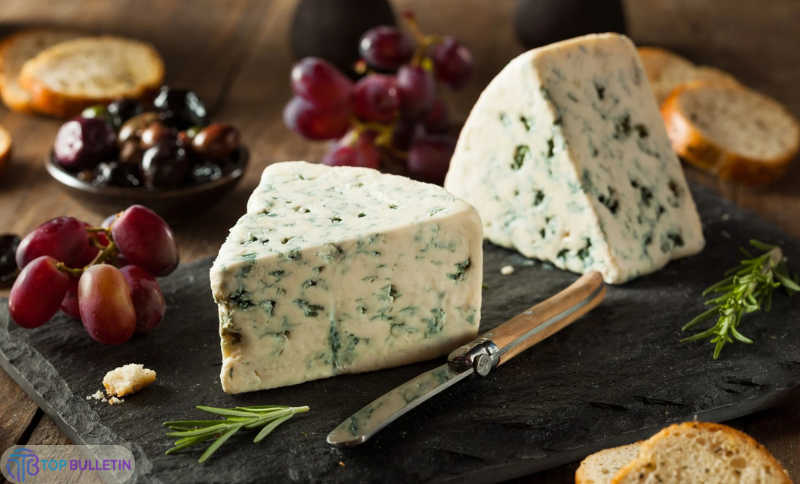Without a doubt, blue_cheese is one of the boldest, most flavorful cheeses in the world. Whether you love it on a burger, in a salad, or as a creamy dip, there’s something irresistible about its strong aroma and tangy bite. Blue cheese is a type of cheese that develops blue or green mold veins throughout during aging. These veins are created using the mold Penicillium, which gives blue_cheese its iconic marbled appearance and distinct flavor.
Naturally, when people first hear the word “mold,” they may be hesitant. But don’t worry — this mold is completely safe to eat. In fact, it’s the same type used in the creation of many gourmet cheeses. If you’ve ever wondered, “Is blue cheese mold?”, the answer is yes — but it’s the good kind.
A Brief History of Blue Cheese
 Interestingly, blue_cheese has been enjoyed for centuries. The first versions are believed to have originated in caves of Roquefort, France. These damp, cool environments provided the perfect conditions for the mold to grow naturally. Over time, cheesemakers began replicating the conditions and intentionally introducing mold to their cheeses. Today, blue_cheese is produced all over the world, including in Denmark, Italy, the United Kingdom, and the United States.
Interestingly, blue_cheese has been enjoyed for centuries. The first versions are believed to have originated in caves of Roquefort, France. These damp, cool environments provided the perfect conditions for the mold to grow naturally. Over time, cheesemakers began replicating the conditions and intentionally introducing mold to their cheeses. Today, blue_cheese is produced all over the world, including in Denmark, Italy, the United Kingdom, and the United States.
Types of Blue Cheese
There are several popular varieties of blue_cheese, and each has a unique taste and texture. Some are milder, while others pack a serious punch. Let’s take a look at the most common types:
Roquefort
-
Origin: France
-
Made from: Sheep’s milk
-
Flavor: Tangy, moist, and crumbly
Gorgonzola
-
Origin: Italy
-
Made from: Cow’s milk
-
Flavor: Buttery and less intense than Roquefort
Stilton
-
Origin: England
-
Made from: Cow’s milk
-
Flavor: Rich, earthy, and slightly nutty
Danish Blue (Danablu)
-
Origin: Denmark
-
Made from: Cow’s milk
-
Flavor: Salty and strong, yet creamy
Is Blue Cheese Good for You?
Yes, and here’s why. Although it’s rich and flavorful, blue_cheese also offers some surprising health benefits. When eaten in moderation, it can be a smart addition to your diet.
Health Benefits of Blue Cheese
-
High in calcium: Great for bone strength
-
Contains probiotics: Supports gut health
-
Rich in protein: Helps muscle growth and repair
-
Good source of Vitamin A and B12: Supports immune function and energy
However, due to its sodium and fat content, it’s best to enjoy blue_cheese in balanced portions. For anyone wondering, “Is blue_cheese good for you?”, the answer is a definite yes — just don’t overdo it.
Blue Cheese Dressing: Creamy and Classic
One of the most iconic uses of this cheese is in blue cheese dressing. It’s the perfect companion for buffalo wings, salads, or veggie platters. You’ll find it in restaurants, delis, and grocery stores everywhere. Still, nothing beats making your own at home.
Homemade Blue Cheese Dressing Recipe
Ingredients:
-
1/2 cup sour cream
-
1/2 cup mayonnaise
-
1 tablespoon lemon juice or white vinegar
-
1/2 teaspoon garlic powder
-
1/4 teaspoon salt and pepper
-
1/2 cup crumbled blue_cheese
Instructions:
-
In a bowl, whisk sour cream, mayo, lemon juice, and seasonings.
-
Add crumbled blue_cheese and mix gently.
-
Chill in the fridge for 30 minutes.
-
Serve and enjoy!
It’s easy, delicious, and packed with flavor. This homemade blue_cheese dressing recipe will elevate any meal you pair it with.
Blue Cheese Dip: Perfect for Parties
If you’re entertaining guests, consider whipping up a quick blue cheese dip. Just blend cream cheese, sour cream, blue_cheese crumbles, and a splash of milk until smooth. Serve it with celery sticks, crackers, or chicken wings. It’s creamy, tangy, and addictive.
Blue Cheese Sauce: A Gourmet Touch
Want to elevate your steak or pasta? Try a blue_cheese sauce. Melt butter in a pan, stir in heavy cream, and gently whisk in crumbled blue_cheese until it melts. Add a pinch of black pepper and serve it warm. It turns a simple meal into something decadent and restaurant-worthy.
How Is Blue Cheese Made?
Believe it or not, the process of making blue_cheese is both scientific and artistic.
-
Milk is curdled using rennet.
-
The curds are separated and molded.
-
Then, the cheese is pierced with needles to allow oxygen inside.
-
Penicillium mold is introduced, and the aging process begins.
As the cheese ages in a cool environment, the mold grows inside the cracks and air pockets, forming the signature blue veins.
Does Blue Cheese Spoil?
 That’s a fair question, and the answer is nuanced. Since blue_cheese is already moldy by design, you don’t need to panic when you see blue spots. However, if it develops fuzzy white, pink, or green mold on the rind — or starts to smell like ammonia — it may have spoiled.
That’s a fair question, and the answer is nuanced. Since blue_cheese is already moldy by design, you don’t need to panic when you see blue spots. However, if it develops fuzzy white, pink, or green mold on the rind — or starts to smell like ammonia — it may have spoiled.
Store it tightly wrapped in the fridge and consume it within 3–4 weeks of purchase for best flavor and safety.
Best Ways to Enjoy Blue Cheese
Let’s explore how you can incorporate blue_cheese into your meals:
-
Crumble it over salads with walnuts and pears
-
Melt it into risotto or mac and cheese
-
Pair with honey on a cheese board
-
Use it in burgers for a creamy, salty kick
-
Stuff into mushrooms or chicken breasts
With its strong flavor, a little goes a long way — but it adds complexity and depth to any dish.
Blue Cheese and Wine Pairing
Pairing cheese with wine is a classic art, and blue_cheese deserves the perfect match. Because it’s sharp and salty, it pairs beautifully with:
-
Sweet wines like Port or Sauternes
-
Bold reds like Cabernet Sauvignon
-
Crisp whites like Riesling or Chardonnay
These combinations balance the intensity of the cheese and make for a luxurious experience.
Bio Table
| Name | Blue Cheese |
|---|---|
| Type | Mold-ripened cheese |
| Color | Creamy white with blue or green veins |
| Flavor | Tangy, salty, and sharp |
| Common Varieties | Roquefort, Gorgonzola, Stilton |
| Calories (1 oz) | ~100–120 calories |
| Health Benefits | Probiotics, calcium, protein |
| Pairs Best With | Wine, salad, steak, dressings |
| Common Uses | Dressing, sauce, dip, topping |
| Storage | Refrigerated in airtight wrapping |
| Made From | Cow’s, sheep’s, or goat’s milk |
| Is It Safe Mold? | Yes, edible Penicillium mold |
Conclusion
In the end, blue_cheese is far more than a love-it-or-hate-it ingredient. It’s rich in flavor, packed with history, and surprisingly nutritious when enjoyed in moderation. Whether you’re crafting a homemade blue_cheese dressing, experimenting with a bold blue_cheese sauce, or simply crumbling it onto a salad, this cheese brings something unforgettable to the table.
So next time someone asks “What is blue_cheese?”, you’ll not only know the answer — you’ll be ready to share a recipe, a wine pairing, or a story to go with it.
FAQs
1. What is blue cheese made of?
Blue_cheese is made from cow’s, goat’s, or sheep’s milk and aged with Penicillium mold.
2. Is blue cheese mold safe to eat?
Yes, the mold in blue_cheese is safe and edible. It’s the reason for its unique flavor.
3. How long does blue cheese last?
When stored properly in the fridge, it can last up to 3–4 weeks.
4. Can I make blue cheese dressing at home?
Absolutely! Homemade blue_cheese dressing is easy, delicious, and customizable.
5. Is blue cheese healthy?
In moderation, yes. It provides calcium, protein, and probiotics.






